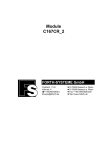Download STart168 - Digi International
Transcript
STart168 Evaluation Kit for ST10F168 Microcontroller FORTH-SYSTEME GmbH P.O. Box 11 03 Kueferstrasse 8 l D-79200 Breisach, Germany l D-79206 Breisach, Germany (+49 (7667) 908-0 l Fax +49 (7667) 908-200 l e-mail: [email protected] STart168 Evaluation Kit Copyright 2000: FS FORTH-SYSTEME GmbH Postfach 1103, D-79200 Breisach a. Rh., Germany Release of Document: Filename: Author: October 30, 2000 STRT168d.DOC Jochen Florath All rights reserved. No part of this document may be copied or reproduced in any form or by any means without the prior written consent of FS FORTHSYSTEME GmbH. 2 STRT168d.doc STart168 Evaluation Kit Table of Contents 1. Introduction.................................................................................................... 5 2. Features of STart168 Evaluation Kit.............................................................. 6 3. Getting started with EVA168 Evaluation Board ............................................. 7 4. Software Tools for EVA168 Evaluation Board ............................................. 10 5. EVA168 Memory-Mapping........................................................................... 11 5.1. Memory-Configuration ....................................................................... 13 5.2. Settings of Jumper J 1....................................................................... 14 6. System Start-up Configuration..................................................................... 15 6.1. EMULATION Mode ............................................................................ 15 6.2. Adapt Mode ....................................................................................... 16 6.3. Bootstrap Mode ................................................................................. 16 6.4. Bus-Access-Types............................................................................. 17 6.5. Write Configuration............................................................................ 18 6.6. Chip-Select-Lines .............................................................................. 18 6.7. Segment Address Lines..................................................................... 19 6.8. RANGE START ADDRESS ............................................................... 21 6.9. EVA168 Memory Layout.................................................................... 22 6.10.Clock Generation .............................................................................. 23 6.11.Single-Chip-Mode.............................................................................. 24 6.12.User Switches and analog Components ........................................... 25 6.13.Switch S2 .......................................................................................... 26 6.14.LED 4, 5, 6, 7 .................................................................................... 26 6.15.LED 1, 2, 3 ........................................................................................ 27 6.16.Push button....................................................................................... 27 6.17.Potentiometer.................................................................................... 27 6.18.CAN Bus-Termination ....................................................................... 28 6.19.RS232 Interface ................................................................................ 28 6.20.Battery Backup.................................................................................. 29 7. Connectors .................................................................................................. 30 STRT168d.doc 3 STart168 Evaluation Kit 7.1. 7.2. 7.3. 7.4. 7.5. CPU signal connector X1 ................................................................... 30 User hardware connector X10............................................................ 31 X4, CAN Connector 1......................................................................... 32 X5, CAN Connector 2......................................................................... 32 X3, RS232 Interface........................................................................... 33 8. Power-Supply............................................................................................... 34 9. User Oscillator.............................................................................................. 35 10. CD-ROM....................................................................................................... 36 10.1.Content of CD-ROM .......................................................................... 36 10.2.DEMO\TASKING ............................................................................... 37 10.3.DEMO\KEIL ....................................................................................... 37 10.4.TOOLS\FLASH .................................................................................. 38 10.5.Board configuration ........................................................................... 38 10.6.Error conditions.................................................................................. 39 10.7.Lauterbach Flash Tool ....................................................................... 39 10.8.Make a project with the TASKING C-Compiler .................................. 40 10.8.1.Memory Mapping.................................................................... 40 11. Know-How for handling C166/ST10F168 IDEs ............................................ 47 12. Appendix ...................................................................................................... 49 Top View of the EVA168 Evaluation Board ............................................... 49 4 STRT168d.doc STart168 Evaluation Kit 1. Introduction The product line of FS FORTH-SYSTEME got a brand new member of userfriendly, easy-to-use and powerful evaluation kits which is offered as ”STart168”. It is shipped with a ST10F168 controller which provides a 256 KByte on-chip Flash memory, a 6 KByte on-chip extension RAM (XRAM), a 2 KByte internal SRAM (IRAM) a CAN controller which works according to ISO11898 (profile 2.0B) and with many additional I/O features. The board supports a up to 1 MByte external Flash memory and 256 KByte Fast-SRAM which allow to build a large number of sophisticated applications. The ST10F168 is a derivative component based on an Infineon C167 architecture but with many additional features. Please refer to the ST10F168 datasheet on the CD-ROM shipped with this package. Check the web page of STMicroelectronics (www.st.com) for updated versions of the device datasheet. An intelligent battery management supports the assembly of an optional, low power 256 KByte SRAM working as non-volatile memory. Furthermore a set of user selectable switches (DIP) offer a very flexible handling of the CPU specific start-up configuration. Therefore the STart168 Evaluation Kit promises a successful start-up development for beginners and experienced users. The EVA168 Evaluation Board comes with a Flash programming tool and a well prepared demo software which helps you to become an experienced specialist for ST10 controllers. The engineers of FS FORTH-SYSTEME created this evaluation board to fulfill a lot of actual and future user requirements. Therefore this kit has been designed to allow the assembly of ST10 controllers with 2 CAN modules. Thus the board comes with two pre-assembled CAN transceivers. Both can easily be used without the need of additional hardware or a redesign of the board’s printed circuit. Furthermore the external memories have been chosen to run the board with a high speed ST10 / 25 MHz controller. For fast prototyping the EVA kit includes a small wire wrap field, a potentiometer for an analog input signal, serial EEPROM, a set of LEDs and a push button to make development easy and simple. Please refer to the following chapters to get into more details about the ST10F168, the board’s capabilities and the tools which are coming with the STart168 Evaluation Kit. STRT168d.doc 5 STart168 Evaluation Kit 2. Features of STart168 Evaluation Kit ♦ ♦ ♦ ♦ ♦ ♦ ♦ ♦ ♦ ♦ ♦ ♦ ♦ ♦ ♦ ♦ ♦ ♦ ♦ ♦ ♦ ♦ ♦ ♦ 6 Evaluation Kit based on the EVA168 Evaluation Board 256 kByte high speed SRAM 512 kByte external Flash 256 KByte, low powered SRAM for optional memory expansion Optional battery back-up circuit for low powered SRAM (see BQ2201SNN) Additional 512 kByte Flash for optional program memory extension Two CAN transceiver (PCA82C250T, ±15V common mode offset voltage) Two CAN plugs (DSUB-9) Selectable bus configuration via DIP switch Selectable bootstrap mode via DIP switch 128 pin connector providing all CPU signals for user purposes Additional wire-wrap field for individual hardwired applications External, serial EPROM (24LC02, I2C-Interface) for user purposes Including a RTC-72423 realtime clock The EVA168 Evaluation Board is designed for running a ST10F168 at 25 MHz and future controllers with two integrated CAN modules, according to ISO11898 (2.0B) Power supply 90..264VAC/5VDC enclosed. Input voltage to the EVA168 Evaluation Board (X2) connector is 5VDC only RS232-Interface cable enclosed Flash programming utility for easy downloading user specific code to external Flash memory. Hex-to-binary converter tool provided on CD-ROM as freeware Flash programming utility for the internal CPU Flash memory provided by Lauterbach Stand alone flash utility to program the embedded on-chip Flash of the ST10F168. C compiler (demo version only) provided by TASKING and KEIL Including a socket to carry a four pin crystal oscillator device Reserved pads to hold an optional ”Quad-Connector” for Lauterbach emulator systems. STRT168d.doc STart168 Evaluation Kit 3. Getting started with EVA168 Evaluation Board As already mentioned above, this paragraph intents to explain how you can run the board without writing own software. You will learn how the controller’s internal bootstrap mode can be used to initiate a simple download of a binary program file to the embedded on-chip and external Flash memories. If you would like to use the environments of KEIL or TASKING you should refer to chapter 10. First we recommend to cerate a project path which will keep the demonstration software, as well as the encapsulated bootstrap and monitor program, both provided on CD-ROM. The bootstrap module is a tiny piece of FS FORTHSYSTEME firmware which is downloaded to the internal 2 kByte SRAM (IRAM) memory of the controller. It makes sure that other programs, like the monitor can be uploaded to any memory location. For more details please refer to chapter 5.1 ”Memory-Configuration”. By the way: the user may select both, the external FLASH or the external SRAM memory to downloaded his individual application software. To setup your board successfully, please take care of the following steps: ♦ Setup the board’s DIP switches as shown in figure 1 (the board is preconfigured by FS FORTH-SYSTEME according to figure 1). Refer to chapter 6 ”System Start-up Configuration” for detailed information about these settings. ♦ Make sure that the BSL switch is set to left position (S4-4=ON / P0L.4=low). This will force the CPU to go into bootstrap mode right after reset or power on. Bootstrap mode is always entered by the CPU whenever pin P0L.4 has been grounded prior to a reset. ♦ Connect the board’s serial RS232 interface to COM1 or COM2 of your Personal Computer. Caution: CTS and RTS signals are not supervised by the board’s serial interface and the bootstrap loader software. ♦ Copy a sample program from the attached CD-ROM into your project path. For example take ”....\EXAMPLES\RTC168_Release\RTC.BIN” which will show you how the realtime clock works on the EVA168 evaluation board. STRT168d.doc 7 STart168 Evaluation Kit Figure 1: Factory setting ( on )* ( off )** EVA168 Board 8 Top View CLKCFG2 CLKCFG1 CLKCFG0 SALSEL1 S4 SALSEL0 CSSEL1 CSSEL0 M29F400 Flash WRC 1 8 BUSTYPE 1 BUSTYPE 0 NC. BSL S3 NC. NC 1 SRAM ADP X10 1 EMU connector to CPU-bus and CPU-I/Os * bus signal grounded via resistor; ** bus signal open white rectangle shows active position of switch 8 STRT168d.doc STart168 Evaluation Kit Example continued : ♦ Copy ”FLASH166.EXE” and ”FLASH166.OVL” onto your hard disk. Both files allow you to run the bootstrap loader and monitor in an opened DOS box. ♦ Make sure that the auto-execution path does include a reference to the new path directory from where to load ”FLASH166”. ♦ Now start the download: Type ”FLASH166 /P EPROM.BIN” at the DOS prompted line and press <RETURN> key. The bootstrap loader tries to connect to COM1 by default. If this does not work properly try to connect to COM2. ♦ Type ”FLASH166 /P RTC.BIN /COM2” and see what happens. If you still have problems to start downloading, please revise the settings of S4 once more. Check if you have chosen the RS232 cable delivered with the Start168 Evaluation Kit. ♦ Now move the BSL switch to the right side (opened) and press the reset button S1. Figure 2: Output of the example RTC168 RTC is read via polling 10:35:10 10:35:11 10.35:12 10:35:13 10:35:14 If everything is working properly the measured realtime of the RTC-72421 device will appear on your PC screen as shown in figure 2. STRT168d.doc 9 STart168 Evaluation Kit 4. Software Tools for EVA168 Evaluation Board The STart168 Evaluation Kit always includes the bootstrap loader and monitor program (FLASH166) from FS FORTH-SYSTEME. That’s everything you need to run your individual software on a ST10F168 controller. This software is a part of the STart168 Evaluation Kit. FLASH166 package allows you ♦ to download your program to an external Flash or SRAM ♦ to request a memory dump from the target ♦ to test serial interface, CPU-I/Os and a lot more things If you would like to use a sophisticated programming tool which provides you the advantages and performance of ”C”, we would appreciate to make you an interesting offer at any time. FS FORTH-SYSTEME is distributor for KEIL and TASKING. Both companies are manufacturer of well known ”C/C++” compilers and debugging tools. For the very first beginning you may use a free demo of the KEIL and TASKING ”C” compilers which allow you to create individual programs with a restricted size of program code. A detailed and well documented description of writing software with TASKING and KEIL environments is attached to this manual. If you want to run the ST10F168 as a standalone controller you may use the Flash utilities which are designed and provided by Lauterbach. It allows a fast download of your program into the internal memory section of the CPU. A second stand alone utility is provided on the CD allowing programming/erasing of the on-chip Flash. 10 STRT168d.doc STart168 Evaluation Kit 5. EVA168 Memory-Mapping The EVA168 evaluation board supports a number of memory architectures according to the capability of the ST10F168 controller. The board is marketed by FS FORTH-SYSTEME with the following components: Table 1: Memory Memory Type Chip-Select Size Comment 1 FLASH, Boot M29F400BB90N1 or M29F800BB90N1 CSFLSHA 256k * 16 or 512k * 16 assembled or optional 2 FLASH, Extension M29F400BB90N1 or M29F800BB90N1 CSFLSHB 256k * 16 or 512k * 16 optional 3 SRAM, High Speed 2 * µPD431008LE or 2 *µPD434008LE CSRAM 2 * 128k * 8 or 2 * 512k * 8 assembled or optional 2 * M5M51008AFP or 2 * M5M5408LE CSRAM_B 2 * 128k * 8 or 2 * 512k * 8 optional 4 SRAM, Low Power All components marked ”optional” are not mounted when the board is leaving FS FORTH-SYSTEME. You may expand the board’s addressable and nonvolatile program memory up to a maximum of 2 MByte (both Flash parts must be a 29F800). The optional static RAM (line 4 in table 1) can be assembled as an alternative memory block which provides lower power characteristics. This memory is interfaced to an external battery back-up and supervisory circuit which prevents loss of data. The circuit with the part number U6 (BQ2201) has to be added to STRT168d.doc 11 STart168 Evaluation Kit the printed board if you want to use the low power RAM block with a maximum size of 1 Mbyte. This circuit generates the /CSRAM_B signal which is derived from the origin CSRAM signal controlled by the CPU’s internal address logic. If power fails this integrated circuit takes care about the power level at /CSRAM_B. To prevent damage of the SRAM block both, the supply voltage and CS_RAM_B must be stable (3V) in case of a power fail situation. Since the selection signal CSRAM_B is derived from the CSRAM signal both memory blocks (3 or 4) may never work at the same time. If you want to have both memory blocks working together you may connect the last chip select signal (/CS4) from the CPU’s address logic. This signal is not used yet and can be interfaced to the BQ2201 through a short wire. 12 STRT168d.doc STart168 Evaluation Kit 5.1. Memory-Configuration Figure 3: Chip Select selection Top View on Print CAN 1 (X4) Oscillator Circuit 5 4 6 3 7 2 8 1 J2 2 1 J1 CAN2 (X5 ) select CS Signals J3 STRT168d.doc 13 STart168 Evaluation Kit 5.2. Settings of Jumper J 1 Table 2: PIN 1 2 3 4 5 6 7 8 9 10 11 12 A B C Chip-Selects Pre-configured CS0 -> CSFLSHA Yes CS1 - > CSRAM Yes CS0 -> CSRAM No CS1 - > CSFLSHA No CS2 - > CSRTC Yes CS3 -> CSFLSHB No = connected pins To make sure that your system works properly you may combine the setting shown in column (A) with column (C) provided that the system boots from an external Flash device. Otherwise if the program resides within an external SRAM you should select column (B) in combination with column (C). The jumper setting (C) works independent of the other selections. Open jumper J1(9)J1(10) (see figure above) for disabling the chip-select signal on the RTC unit. Since the board comes without the second Flash device J1(11)-J1(12) are removed. All jumpers which are marked as pre-configured are set by FS FORTH-SYSTEME prior to delivery. 14 STRT168d.doc STart168 Evaluation Kit 6. System Start-up Configuration Although most of the programmable features of the ST10F168 are either selected during the initialization phase (software) or repeatedly done during the program execution (software), there are some configurations that MUST be selected earlier, because they are used for the very first access of the CPU (hardware). For example, the CPU has to know how to deal with the external bus interface since the external memory may be organized as an 8 bit multiplexed/non multiplexed or a 16 bit multiplexed/non multiplexed bus. These selections are made during reset at the pins of PORT0, which are read at the end of the internal reset sequence. During reset CPU-internal pull-up devices are active on the PORT0 lines which results into a high level state, if the respective pin is left open. Otherwise the pin must be pulled down by an external resistor (4.7k..8.2k) if the user wants to select any other CPU option at this certain pin. The following paragraphs explain how to set all of these start-up configuration pins. Please refer to chapter 2 figure 1 to find out the corresponding switches located at S3 or S4. If a bit has to be configured as 0 move the switch to the left position (see 0 in figure 1). A logical 1 appears when the switch is set to the right location (see 1 in figure 1). 6.1. EMULATION Mode PIN EMU, S3-1 Pin P0L.0 selects the Emulation Mode, when low during reset. This mode allows the access to the integrated XBUS peripherals via the external bus interface. This mode is used for special emulator purposes and is in general of no use in basic applications. Default: Emulation Mode Off (P0L.0=1 / S3-1=off) STRT168d.doc 15 STart168 Evaluation Kit 6.2. Adapt Mode PIN ADP, S3-2 Pin P0L.1 selects the ADAPT Mode when low during reset. In this mode the ST10F168 goes into a passive, floating state, which is similar to its state during reset. This mode allows switching a ST10 that is mounted on board virtually off, so an emulator may control the circuitry since the pins are floating even if the original controller remains in its place. This mode is used for special emulator purposes and is generally not used in basic applications. Default: Emulation Mode Off (P0L.1=1 / S3-2=off) 6.3. Bootstrap Mode PIN BSL, S3-5 Pin P0L.4 activates the on-chip bootstrap loader when switch S3-5 is on during reset. The bootstrap loader allows moving a tiny start code (about 32 Byte) into the internal RAM of the ST10F168 via the serial controller interface ASC0 (asynchronous, serial mode). The controller remains in BSL mode until a hardware reset with P0L.4 set high occurs. Bootstrap loader mode may also be exited through a software reset instruction. In this case P0L.4 is ignored and program execution starts fetching code from 0x00000 (internal or external). Refer to the user manual for more details. Default: Bootstrap Mode On (P0L.4=0 / S3-5=on) 16 STRT168d.doc STart168 Evaluation Kit 6.4. Bus-Access-Types PIN BUSTYPE0, S3(7) PIN BUSTYPE1, S3(8) Pins P0L.7 (BUSTYPE1) and P0L.6 (BUSTYPE0) Table 3: Boot Bus Mode Selection S3-8 S3-7 External Width Data Bus External Address Bus Mode on on 8-bit Data Demultiplexed Addresses on off 8-bit Data Multiplexed Addresses off on 16-bit Data Demultiplexed Addresses off off 16-bit Data Multiplexed Addresses In multiplexed bus modes PORT0 drives both the 16-bit intra-segment address and the 8 (16) bit output data, while PORT1 remains in high impedance state. In demultiplexed bus modes PORT1 drives the 16-bit intra-segment address, while PORT0 (P0H, P0L) drives the 16-bit Data output. If a 8-bit data width has been selected, only P0L is driving the data output. Default: Data-Bus-Width = 16; Bus Mode = Demultiplexed STRT168d.doc 17 STart168 Evaluation Kit 6.5. Write Configuration Pin WRC, S4-1 Pin P0H.0 selects the initial operation of the control pins /WR and /BHE. When set high (P0H.0=1 / S4-1=off), this pin selects the standard mode, i.e. /WR and /BHE. When set low (P0H.0=0 / S4-1=on) the alternate function is selected, i.e. /WRH and /WRL. Default: /WRL and /WRH selected (P0H.0=0 / S4-1=on) 6.6. Chip-Select-Lines PIN CSSEL0, S4-2 PIN CSSEL1, S4-3 Defines the number of active chip select lines after reset. This allows the selection which pins of port 6 drive external chip select signals and which may be used for general purpose I/O lines. Table 4: Chip Select Selection S4-3 S4-2 active chip select Note off off /CS0.../CS4 Presetting of EVA168 off on none Port 6 Pins free for I/O on off /CS0.../CS1 on on /CS0.../CS2 18 STRT168d.doc STart168 Evaluation Kit 6.7. Segment Address Lines PIN SALSEL0, S4-4 PIN SALSEL1, S4-5 During reset this control lines define the number of active segment address lines. This allows to select pins of port 4 to work as general I/O lines as well as to become a part of the controller address logic. Depending on the selection of SALSELx, the required address space is chosen right after the system start-up and the program may address all locations without prior programming. Even if not all segment address lines are enabled on port 4, the ST10 uses it’s complete 24-bit addressing mechanism. This allows to generate all CS signals over the entire address space even if the external bus width is less in size. CAUTION! The selected number of segment address lines cannot be changed by software after reset. Table 6: Segment Address Lines Selection S4-5 S4-4 Segment Address Lines Directly addressable space off off A17.....A16 256 kByte off on A23.....A16 16 Mbyte, CAN module disabled ! off on A20.....A16 2 Mbyte, CAN 1 module enabled on off None 64 kByte on on A19.....A16 1 Mbyte; Default state of EVA168 Example: Assume that your application requires the 128 kByte SRAM block at the absolute address 0x3FFFFF. Furthermore the CS1 signal should control both reading from and writing to the SRAM. The controller must at least supervise the address lines A0 to A16 in the direct addressing mode (SALSELx = 11). STRT168d.doc 19 STart168 Evaluation Kit Example cont’d 256 kByte block 128 kByte 0x3FFFFF A0... A16 A0....A17 SALSELx = 11 Define BUSCON1 Register: CSWEN = CSREN = 1, RDYEN1 = 0; BUSACT1 = 1 ALECTL1 = 0; BTYP = 10; etc.... Define ADDRSEL1 Register RGSZ (Range-Size-Selection) = 0101 (128 kByte block) RGSAD (Range-Start-Address ) = RRRRRRRxxxxx 20 STRT168d.doc STart168 Evaluation Kit 6.8. RANGE START ADDRESS Depending on the chosen block size (see previous example) the range start address specifies the upper bits (A23....A12) of the respective address area. An ”R” stands for a bit which has to be set within the RGSAD register if this address line is not supervised by the controller bus logic. All bits expressed as an ”x” are exclusively maintained by the bus address signals. Referring to the example, the register configuration ”RRRRRRRxxxxx” lets A12 to A16 being controlled by the controller address bus. The address lines from A17 to A23 are configured within the RGSAD bits which will be taken by the CPU to compute the internal, absolute 24-bit address. All memory areas which are not handled by BUSCON(x) and ADRSEL(x) (x = 1...4 ) are maintained by BUSCON0 and ADRSEL0. Now specify ADRSEL1 register: 0x3FFFFF = 0011.1111.1111.1111.1111.1111 * RGSAD = 0011.1110.0000 ** ADRSEL1 = 0011.1110.0000.0101 * controlled by bus address lines A0..A16 **cursive bits are discarded since they are already controlled by address bus STRT168d.doc 21 STart168 Evaluation Kit 6.9. EVA168 Memory Layout The following table shows some address selections which are only suggestions by FS FORTH-SYSTEME. The memory areas may be changed to fulfill different user requirements. Use BUSCONx, ADRSELx register and the configuration registers as already described in a previous chapter to setup your individual memory layout. Table 7: Typical Memory Layout Address Range Chip-Select Bus Width Function 0x4F.FFFF /CS4 ? Not connected yet /CS3 16 bit Flash Extension, up to1 MByte /CS2 8 bit RTC; 4 kByte /CS1 16 bit SRAM, up to 1 MByte /CS0 16 bit Boot-Flash, up to 1 MByte 0x40.0000 0x3F.FFFF 0x30.0000 0x20.0FFF 0x20.0000 0x1F.FFFF 0x10.0000 0x0F.FFFF 0x00.0000 22 STRT168d.doc STart168 Evaluation Kit 6.10. Clock Generation PIN CLKCFG0, S4-6 PIN CLKCFG1, S4-7 PIN CLKCFG2, S4-8 Since the ST10F168 includes an internal PLL circuit, the external oscillator device does not need to be driven by a high frequency crystal (Quartz). The external oscillator output either directly feeds the CPU and peripherals or it is connected to the on-chip PLL circuit which then provides the CPU clock. Table 8: PLL selection S4-8 S4-7 S4-6 off off off off on off off on on X off on off on X CPU-Clock Fcpu = fxtal * F fxtal * 4 fxtal * 3 fxtal * 2 fxtal * 5 fxtal * 1 External Clock Input PLL mode Range in MHz 2.5 to 6.25 active 3.33 to 8.33 active 5.0 to 12.5 active 2.0 to 5.0 active (*) 1.0 to 25 inactive (*) The EVA168 Evaluation Board comes with an external 5 MHz oscillator circuit. The CLKCFG pins are set by default to a factor of 5 (CPU internal = 25 MHz !). XAL1 Oscillator Circuit PLL Circuit XTAL2 M U X fcpu FPLL = F * fin F 3 STRT168d.doc 23 STart168 Evaluation Kit 6.11. Single-Chip-Mode In single chip mode the program is fetched from the on-chip Flash memory. Therefore the embedded Flash memory must contain a valid program to execute correctly. A utility for this can be found on the CD shipped with your EVA168 Evaluation Board. Single chip mode is entered when pin /EA is set high during reset. Switch S2-3 to ON position before restarting the evaluation board. If the switch is set OFF a pull-down resistor configures the CPU to run in external bus mode. Refer to figure 4 on page 25. 24 STRT168d.doc STart168 Evaluation Kit 6.12. User Switches and analog Components The EVA168 Evaluation Board includes a wire-wrap field, four LEDs and analog components for user specific purposes like self-training and trials. Most of them are directly wired with connector X10 and X1 whereby this components can be accessed by the CPU’s port lines. A small serial EEPROM (24LC01) allows to store and restore user data through a standard I2C-Bus interface. To create a simple application the evaluation board comes with a set of junction cords which are provided to interface the CPU- connector X1 with X10. To access these user components, you must connect your selected component from connector X10 to the CPU connector X1 with external wire, e.g. like the wires shipped with your EVA168 Evaluation Board. Push-Button (S8) S2 LED 8 5 7 6 5 4 3 2 1 User-/System Switch 1 X10 X1 4 Potentiometer P1 7 6 24LC02 Figure 4. Refer also to the attached top view schematics in the appendix. STRT168d.doc 25 STart168 Evaluation Kit 6.13. Switch S2 PIN Function description X1 X10 1 If ON the VPP programming voltage is controlled by P2.0 Switch S2.2 OFF to prevent a short circuit If ON the VPP programming voltage is automatically controlled by the reset signal RSTIN. Switch S2.1 OFF to prevent a short circuit If ON the /EA pin of the CPU is set to +5V starting the device in single chip mode. A pull down resistor terminates the /EA pin at the CPU part if switch is off ! If ON disable oscillator Watchdog 16c --- 11a --- 2 3 4 5 6 7 8 USER-Switch 1: If ON pulls down the pin becomes high active ( 5V ) USER-Switch 2: If ON pulls down the pin becomes high active ( 5V ) USER-Switch 3: If ON pulls down the pin becomes high active ( 5V ) USER-Switch 4: If ON pulls down the pin becomes high active ( 5V ) 12d 13d signal at X10.1 otherwise X10.1 signal at X10.2 otherwise X10.2 signal at X10.3 otherwise X10.3 signal at X10.4 otherwise X10.4 Table 9. 6.14. LED 4, 5, 6, 7 All user LEDs are pulled into a high active level (5V) through a series resistor (1K5). Switching one of these LEDs ON, the CPU signal, interfaced to X10, must be pulled down by software. LED 5 4 7 6 Table 10. 26 Pin of X10 6 5 8 7 STRT168d.doc STart168 Evaluation Kit 6.15. LED 1, 2, 3 Please refer to the top view schematic attached in the manual’s appendix! LED 1 2 3 Table 11 Name POWER VPP EINIT Function Power On/Off signal On if programming voltage VPP is switched on Off after Reset, On after execution of EINIT 6.16. Push button Gets into high level state when key is being pressed. Signal is interfaced to X10.11 connector. 6.17. Potentiometer This variable resistor allows the adjustment of the reference voltage provided by the CPU (connector X1.30c). The voltage can be adapted to the user specific application via X10.12. VREF X1(30c) USER_ANA1 X10(12) AGND Figure 5. STRT168d.doc 27 STart168 Evaluation Kit 6.18. CAN Bus-Termination A CAN bus system has to be terminated at both ends of the network with two resistors. The resistors should have a value of nominal 124 Ω (typically 120 Ω). The terminating resistor can be activated through jumpers J2 (CAN1) and J3 (CAN2). Caution: Never use more than two termination resistors for a network. This might result into any unexpected bus transmission errors or may force the transceiver circuits to drop down their operation. You can use microcontroller with a second CAN interface. For that the user may wish to interface the controller CAN signal lines to the second CAN connector which is already a part of the EVA168 Evaluation Board! 6.19. RS232 Interface The RS232 is interfaced to the board through connector X3 (see figure 6.0 on next page). It allows the download of user the monitor and bootstrap loader as well as the user application file. If the monitor is not in use this interface can be taken as a standard RS232 for individual purposes. The RS232 hardware does not support any handshake signals, like RTS, CTS or DTR. 28 STRT168d.doc STart168 Evaluation Kit 6.20. Battery Back-up A Lithium Battery (3V) is also included on the EVA168 Evaluation Board when shipped to our customers. It supplies both low-powered SRAMs, provided they exist on board (not mounted on EVA168). According to the position of jumper J4 the battery can be removed from supplying the SRAMs. X2 PowerConnector ResetButton X3 J4 3 V Battery RS232 Figure 6. STRT168d.doc 29 STart168 Evaluation Kit 7. Connectors 7.1. CPU signal connector X1 Row 1 2 3 4 5 6 7 8 9 10 11 12 13 14 15 16 17 18 19 20 21 22 23 24 25 26 27 28 29 30 31 32 30 PIN A Address A0 Address A2 Address A4 Address A6 Address A8 Address A10 Address A12 Address A14 Address A16 Address A18 /RESTIN /CS0 /CS2 /CS4 PORT 6.6 CAN_TXD1, P4.6 PORT 8.0 PORT 8.2 PORT 8.4 PORT 8.6 PORT 7.0 PORT 7.2 PORT 7.4 PORT 7.6 PORT 5.0 PORT 5.2 PORT 5.4 PORT 5.6 PORT 5.8 PORT 5.10 PORT 5.12 PORT 5.14 PIN B Address A1 Address A3 Address A5 Address A7 Address A9 Address A11 Address A13 Address A15 Address A17 Address A19 /INT_RTC /CS1 /CS3 PORT 6.5 PORT 6.7 CAN_TXD2, P4.7 PORT 8.1 PORT 8.3 PORT 8.5 PORT 8.7 PORT 7.1 PORT 7.3 PORT 7.5 PORT 7.7 PORT 5.1 PORT 5.3 PORT 5.5 PORT 5.7 PORT 5.9 PORT 5.11 PORT 5.13 PORT 5.15 PIN C Data D0 Data D2 Data D4 Data D6 Data D8 Data D10 Data D12 Data D14 NC TXD0, serial /RSTOUT ALE /NMI CAN_RXD1, P4.5 CAN_RXD2, P4.4 PORT 2.0 PORT 2.2 PORT 2.4 PORT 2.6 PORT 2.8 PORT 2.10 PORT 2.12 PORT 2.14 PORT 3.15 PORT 3.9 PORT 3.7 PORT 3.5 PORT 3.3 PORT 3.1 VAREF GND VDD (+5V) PIN D Data D1 Data D3 Data D5 Data D7 Data D9 Data D11 Data D13 Data D15 NC RXD0, serial /READY /EA /RD /WRH, P3.12 /WRL, PORT 2.1 PORT 2.3 PORT 2.5 PORT 2.7 PORT 2.9 PORT 2.11 PORT 2.13 PORT 2.15 PORT 3.13 PORT 3.8 PORT 3.6 PORT 3.4 PORT 3.2 PORT 3.0 VPP GND VDD (+5V) STRT168d.doc STart168 Evaluation Kit 7.2. User hardware connector X10 PIN 1 2 3 4 5 6 7 8 9 10 11 12 13 14 15 16 FUNCTION User Switch 1 User Switch 2 User Switch 3 User Switch 4 User LED 4 User LED 5 User LED 6 User LED 7 I2C Bus Clock Line I2C Data Read/Write Line User Pushbutton Analog Voltage from potentiometer NC NC NC NC STRT168d.doc 31 STart168 Evaluation Kit 7.3. X4, CAN Connector 1 PIN 1 2 3 4 5 6 7 8 9 Signal NC CAN_L, differential Low signal GND, optional NC NC GND, optional CAN_H, differential High signal NC VCC ( 5V ), optional 7.4. X5, CAN Connector 2 PIN 1 2 3 4 5 6 7 8 9 Signal NC CAN_L, differential Low signal GND, optional NC NC GND, optional CAN_H, differential High signal NC VCC ( 5V ), optional Pin 2 and 7 may be connected via a terminating resistor (120 Ω) via jumpers J2 and J3. Refer to chapter 6.18 ”CAN Bus-Termination” 32 STRT168d.doc STart168 Evaluation Kit 7.5. X3, RS232 Interface PIN 1 2 3 4 Signal NC TXD RXD NC 5 GND 6 DTR0, static 10V, no handshake 7 NC 8 NC 9 NC The housings of all DSUB connectors are grounded. STRT168d.doc 33 STart168 Evaluation Kit 8. Power-Supply The EVA168 Evaluation Board expects a stabilized 5 VDC (±0.25V) voltage at the X2 power connector. An external power mains unit is also part of the STart168 Evaluation Kit. CAUTION: DON’T USE ANY OTHER POWER SUPPLY THAN THAT ONE COMING WITH THE START168 EVALUATION KIT. OTHERWISE YOU TOLERATE THE DAMAGE OF THE ENTIRE BORD ! IN THIS CASE WE CANNOT GRANT ANY WARRANTY! 34 STRT168d.doc STart168 Evaluation Kit 9. User Oscillator The oscillator unit (5MHz) is already plugged into an 8 DIP socket module (refer to the G2 part on top view schematics) when shipped to our customers. It is pretty easy to replace this part by your own, individual circuitry. Just remove the oscillator from the DIP socket and replace it by your discrete solution. This could be a small, 3-pin printed circuit, which keeps everything to run the CPU through an external crystal. 8 XTAL2 XTAL1 Q1 4 1 GND STRT168d.doc 35 STart168 Evaluation Kit 10. CD-ROM Within the STart168 Evaluation Kit you will find everything you need for a fast start-up development. Two C compilers (demo versions) coming from KEIL and TASKING allow you to write small sample programs or to run the examples provided on the CD-ROM. The use of the compiler is reduced in life span (30 days) and memory size. You will find datasheets of the devices on the CD-ROM as well as a utility to program and erase the embedded Flash memory. 10.1. Content of CD-ROM On your CD, you can find four main directories. The content is described below. Please refer to the TXT files in the sub-folders for more detailed description. DC166 This directory contains the Tasking demo, board configuration for the monitor and examples. Keil Keil demo, monitor, examples. Manual Manual of this Evaluation Kit and datasheets for the ST10F168. Tools This directory contains tools for programming the external/internal Flash of the F168 and the PLS demo debugger. 36 STRT168d.doc STart168 Evaluation Kit 10.2. DEMO\TASKING Examples which can be build using a TASKING C compiler (full or demo version). RTC168_Debug: Shows how the realtime clock works and how to make a project for a debug session. RTC168_Release: Shows how the realtime clock works and how to make a project for the on-board Flash. 10.3. DEMO\KEIL Examples which can be build using a KEIL C compiler (full or demo version). RTC168_Debug: Shows how the realtime clock works and how to make a project for debug session. RTC168_Release: Shows how the realtime clock works and how to make a project for the on-board Flash. STRT168d.doc 37 STart168 Evaluation Kit 10.4. TOOLS\FLASH In this folder you will find the FLASH166 tool which have already been mentioned in this manual. Furthermore this directory also keeps the technical documentation of the Flash tool where you can find all information you need for debugging and downloading binary dumps into the Flash circuit. FLASH166 supports a lot of different Flash memory types. Each sample folder for the release version includes a certain batch execution file (doit.bat or prog.bat) which makes it easy for you to create a binary dump. FCONV is used to generate a binary output file based on a hex file typically generated by all C compilers. Since FLASH166 expects a binary formatted file you should use FCONV and FLASH166 to program the ST10F168 controller. You must not pay attention to these subjects if you are using any other programming tool. We are permanently upgrading the FLASH166 tool. So we actually support a large number of different standard FLASH memories. If you are planning to use a Flash type which is not supported by FLASH166 yet, you should not hesitate to contact us. 10.5. Board configuration For each demonstration program refer to the associated text file, like rtc.txt or abstract.txt. Herein you find all technical details about the board configuration, CPU speed and other parameters. The PDF file, provided by STMicroelectronics, gives you a well documented overview about what this certain demo program is intended to do. 38 STRT168d.doc STart168 Evaluation Kit 10.6. Error conditions Batch file does not run: Make sure that you have adapted the batch file according to your individual path structure. You may be forced to edit the batch file slightly. Wrong Flash number: Please note that FLASH166 expects a Flash device at the address 0x00.0000 (/CS0). If you have changed the chip selection lines this error message occurs. The switch ”/CSx” changes the chip select line. Bootstrap mode timeout. Make sure that you have connected a serial (RS232) cable to COM1 (COM2) and X3 of your board. Then press the RESET push button again. Check if the BSL switch is into bootstrap mode (BSL=0). If you are using a serial interface different than COM1 you must revise the ”doit.bat” file according to: ”flash166 /P <file.bin> /COM2”. 10.7. Lauterbach Flash Tool This tool allows programming the internal Flash memory of the ST10F168 controller. The tool is provided within the tool directory on CD-ROM. STRT168d.doc 39 STart168 Evaluation Kit 10.8. Make a project with the TASKING C-Compiler According to the sample project ”\DC166\EXAMPLES\RTC168_RELEASE \RTC.PJT” we at FS FORTH-SYSTEME would like to show you how to create a fast start-up program. For the Keil compiler we have written the start-up file ”START168.A66”. It is not intended by this chapter to explain the C compiler nor the CrossView debugger in detail. For that please refer to the online help files coming with the compiler demo package. The RTC sample initializes and reads the RTC72423A realtime clock while running in a loop. The registers which are read, are written to the serial interface ASC0 (RS232). Therefore you should connect your PC to connector X3 through an appropriate standard cable. To watch the data coming from the EVA168 evaluation board run a standard terminal program, like HyperTerminal, and look what happens. 10.8.1. Memory Mapping Since we do not want to run the program by the CrossView debugger we have to generate an Intel-formatted hex file without carrying any debug information. Furthermore the program memory should be located at 0x00.0000 and is controlled by /CS0. The SRAM is located as a word oriented memory (2 * 128 kByte) which follows right after this first program section (/CS1). At last the RTC uses a 4 kByte memory block and should be supervised through /CS2. Address Range Chip-Select Bus Width Function 0x20.0FFF 0x20.0000 /CS2 8 bit RTC; 4 kByte 0x13.0FFF 0x10.0000 /CS1 16 bit 256KSRAM 0x0F.FFFF 0x08.0000 /CS0 16 bit 512K Program, optional 0x07.FFFF 0x00.0000 40 512K Program STRT168d.doc STart168 Evaluation Kit Use the EDE setup menu to define all CPU and memory specific parameters. Type EDE à Project Options and deselect ”ROM or RAM monitor”. Otherwise the EDE will reserve a certain amount of memory which is requested to run the CrossView debugger in the SRAM or Flash memory. STRT168d.doc 41 STart168 Evaluation Kit Set parameters for bus mode and address selection. All settings will be automatically updated within the startup.asm file whenever you build the project. There is no need to modify the start-up file manually. Just take a start-up file (template) from the INCLUDE directory of your C/C++ compiler CD-ROM and copy it into your project path (see EDE->Project properties). If you like to change the start-up file by your own, use a make utility and don’t run the compiler’s build option! 42 STRT168d.doc STart168 Evaluation Kit STRT168d.doc 43 STart168 Evaluation Kit CAUTION: Just enter the address bits A23 to A12 of the start address. If you enter the complete address your program could fail. The control signals /CS1 is associated with ADDRSEL1 register definition; /CS2 associates with ADDRSEL2 and so on.... 44 STRT168d.doc STart168 Evaluation Kit Define where RAM and ROM (Flash) sectors are located within your individual application. If you wish to use internal components like CAN or XRAM you must consider these parts through a declaration within this menu section. STRT168d.doc 45 STart168 Evaluation Kit Generate an Intel-formatted hex dump which is converted into a binary output afterwards and download it into the Flash with the FLASH166 tool. If you like to run the CrossView debugger select ”IEEE-695” format including debug information. 46 STRT168d.doc STart168 Evaluation Kit 11. Know-how for handling C166/ST10F168 IDEs There is no general way how to handle IDEs to get fast and good results but we can give some useful hints to avoid mistakes. There are a few differences in handling projects for debugging the application and for making a release version for the ROM. For debug session, you need a RAM or ROM monitor. This is a small program which initializes registers and provides functions in order to make your hardware able to communicate with a debugger, usually via serial line. The most important point is that the registers for RAM memory are set to a correct value by the monitor because the remote debugger loads your application into RAM and has to modify it for setting breakpoints. Please have a look on \dc166\etc\EVA168.CFG. A RAM monitor is loaded via bootstrap loader, the ROM monitor has to be programmed into the ROM (Flash) and is automatically activated after RESET. This Evaluation Kit works mainly with RAM monitors because the download time is so short that a direct start from ROM yields no advantages. Please make sure that your application doesn’t overwrite the monitor in the RAM! For release, you have to link a ”start-up” to your application, which is automatically started after RESET. The start-up is usually an assembler program linked to your application (Keil example RTC168_Release) or is automatically generated via the project settings (Tasking example RTC168_Release). The memory settings for linker/locator has to match with the start-up settings! I.e., if you set the address selection register for RAM to 100 000h and locate your data to 10 000h your program won’t run. STRT168d.doc 47 STart168 Evaluation Kit Generally, the start-up initializes your hardware. Please check the settings for memory access times for RAM and ROM (Flash) to avoid your hardware running slower than it could. If you have any questions, please don’t hesitate to contact the Technical Support of FS FORTH-SYSTEME! 48 STRT168d.doc STart168 Evaluation Kit 12. Appendix 12.1. Top View of the EVA168 Evaluation Board STRT168d.doc 49

















































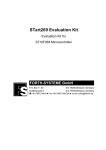

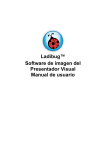

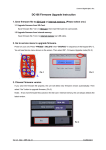
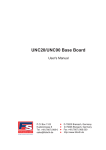
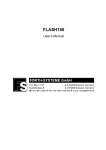
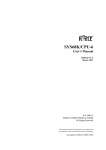

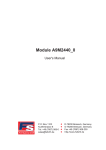
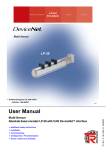
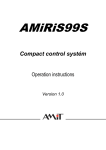

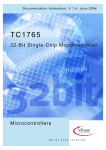
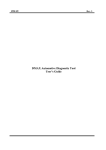
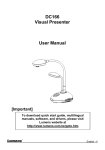
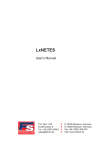
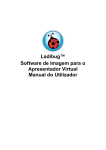
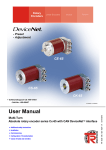
![TestBed User Manual [PDF/1177KB]](http://vs1.manualzilla.com/store/data/005689366_1-da15ee0f5e0f03b5bd1516fa499d012b-150x150.png)
